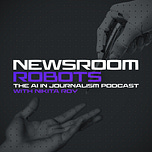Translating a journalist's gut instinct into code—is it possible? In Norway, iTromsø—a long-standing regional newspaper known for its investigative journalism and deep local coverage—has found a way.
iTromsø’s AI system, DJINN (Data Journalism Interface for News Gathering and Notification), doesn’t just scan documents—it replicates the instincts of the newsroom’s most seasoned reporters. Feed it 400 municipal filings, and it will surface the ones a veteran journalist would have flagged. The impact? In their first week, summer interns using the system produced five front-page stories. Fresh out of journalism school, they broke major urban development stories, a beat that typically takes years to master.
In the latest episode of Newsroom Robots, I spoke to Rune Ytreberg and Lars Adrian Giske about iTromsø’s structured approach to AI-driven reporting and how they built tools that strengthen their local journalism.
Rune leads iTromsø’s data journalism lab, where he has been developing AI-driven editorial solutions for 70 local newspapers within the Polaris Media Group since 2020. And Lars is the Head of AI at iTromsø and led the development of DJINN. Since its launch in 2023, 36 newspapers across Norway have adopted DJINN, sourcing documents from nearly half of all Norwegian municipalities.
iTromsø’s AI journey began with what Rune describes as "low-hanging fruit"—a property bot that tracked real estate transactions and alerted journalists to noteworthy sales. This simple yet powerful tool became so effective that it was eventually adopted by 70 newspapers across their parent company, Polaris Media.
Building on that foundation, iTromsø developed LAILA, a research assistant designed to sift through massive datasets and uncover newsworthy leads. Over time, this evolved into more specialized tools, including a fisheries database system that analyzes millions of fish transactions to detect potential illegal activities.
This 25-person newsroom is demonstrating how AI can enhance local journalism, enabling journalists to work smarter and faster. Here are my three key takeaways from our conversation:
1️⃣ The Power of Domain-Specific AI
Rather than developing general-purpose AI tools, iTromsø focuses on specialized assistants tailored to specific beats, such as urban development or healthcare. As Rune explained, this approach reduces the risk of AI hallucinations while making the tools more precise and valuable for journalists. By embedding the expertise of senior reporters into these systems, they enable new journalists to quickly develop beat expertise.
2️⃣ Editorial Leadership is Key
At iTromsø, AI development begins with editorial needs, not technology. DJINN was created through extensive workshops with beat reporters to gain a deep understanding of their workflows and pain points. As Lars, who transitioned from investigative journalism to AI development, explains, journalists must play an active role in shaping AI to address real newsroom challenges.
3️⃣ AI as an Extension of Data Journalism
iTromsø sees AI as a natural evolution of data-driven reporting. Their tools help journalists identify patterns in large datasets, surface newsworthy leads faster, and free up time for verification and investigative work—all while keeping human editorial judgment at the center.
This work is transforming how journalism evolves. As experienced journalists retire or move on, their expertise doesn’t have to be lost. New reporters can get up to speed faster, ensuring continued depth in coverage even when key staff are away. Most importantly, AI reduces the time spent sifting through documents, allowing journalists to focus on deeper investigations.
In our next episode, Rune and Lars share how they are developing personalized AI research assistants—tools designed to proactively surface news leads based on a journalist’s area of focus. Imagine logging into your newsroom’s system and finding a curated list of potential scoops, tailored to your beat by AI.
iTromsø’s success proves that innovation with AI doesn’t require a massive tech team—just a clear editorial vision and a commitment to making technology work for journalists. 🎧 Listen to our full conversation available now on Apple, Spotify and other major podcast platforms
.📢 Join us for a live online session where Jeremy Caplan and I take you inside our AI toolkit!
In this lightning talk, we’ll break down the AI tools we actually use daily and how they help us in our workflow. You’ll also hear from Carla Nudel, Digital Product Manager at The New Republic, as she shares how she’s developing an AI-powered tool for SEO optimization and its impact on newsroom workflows.
Join us for actionable insights, hands-on examples, and an exclusive look at the AI tools that can help you work smarter in 2025!
📆 Date: Wednesday , February 26, 2025
⏰ Time: 12:00 PM EST (45 minutes)










